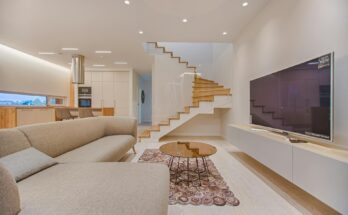Enis Karavil’s home renovation in London was what helped him refine his aesthetic and lead to his own design company. However, he spent most of his weekends in Notting Hill, looking at Portobello market, which is a mile-long street of vendors that have congregated there since the late 1870s. This market, which has been home to rag and bone men, basically cart-wielding junk sellers, has, over the past eight decades, become an epicenter of antiques and other eccentric bric-a brac. Karavil’s frequent outings and the vibrant atmosphere of Notting Hill inspired him to search for a home. He first offered on a three-story London villa. But then he saw an apartment that covered two floors of a stucco fronted townhouse, built in the mid-19th-century. Though it needed considerable love, he knew, largely thanks to an original marble fireplace with neo-Classical corbel detailing and an unusual wrought-iron spiral staircase, that it was where he wanted to be.ImageBeside a glass-topped dining table of Karavil’s own design, a collection of anonymous portraits picked up from markets and antiques fairs across Europe.Credit…Simon UptonImageOn the mantel, a glass bell jar filled with painted mushrooms.Credit…Simon UptonWhat he did not yet know was that renovating the home would usher in a new creative chapter for him. Karavil spent five months trying to restore the property’s quiet charm that had been slowly eroded by neglect and haphazard interventions over the years. He says, “I wanted the interior to reflect the architecture of the building so that everything felt like it had been there since the beginning.” In some ways, this meant that things had to be restored the way they were. Karavil began in the south-facing sitting area that anchors the apartment. He restored decorative plasterwork molding, repaired the trio of round-topped windows opening onto a long balcony, and tore down ceiling storage. This was a departure from the historical record. The space’s combination of old and modern elements is what makes it so appealing. Karavil removed the door that led to the kitchen’s boxed-in entryway and built a serving hatch in the wall connecting the kitchen and the living room. He also painted the walls bone white — rather than any of the deep hues the Victorians might have favored when the home was built — installed custom stainless-steel cupboards in the kitchen and laid a reclaimed pinewood floor sourced from an old English tobacco factory throughout.ImageIn the center of the room sits a brown leather sofa by Umberto Asnago for Arflex that’s set with embroidered cushions from Karavil’s own line, Sanayi313.Credit…Simon UptonAnother notable tension is that, for someone who loves collecting, Karavil has kept the rooms remarkably and intentionally spare. The seating in the living room largely consists of a single sofa — a boxy brown leather design by Umberto Asnago for Arflex — a vintage black pony skin club chair from the Nicole Farhi store in Chelsea and a trio of small, mother-of-pearl-inlaid dining chairs from an antiques store in Marylebone. A Serge Mouille floor lamp and a television-shielding, lacquered screen with mesh, gold patina detailing, and a metal-trimmed teastand complete the seating in the living room. There is also a single sofa, a vintage black pony skin club chair by Umberto Asnago for Arflex, and three small, mother-of-pearl-inlaid dining chairs from an antiques store in Marylebone. A glass dome that houses a trio of dried and glazed mushrooms is located on the mantel of the marble fireplace. The dark, globular forms of these mushrooms look like they are part art and part science project. An old butcher’s block is also found on the dining table, along with vintage stationery. Karavil discovered an antique alligator rug, nicknamed Bob, at a Chelsea fair 2016. A set of custom shelves in the corner of the room houses pieces from Karavil’s collection of over 100 silver teapots. This was originally a nod towards the English tradition of afternoon tea and to Karavil’s grandmother Sol’s extensive collection of silverware. It has since grown into a full-scale obsession. He owns a pyramidal version from Paris’ Marche aux Puces and a plexiglass handle from London’s Lots Road Auction House. They are tiny little things. It’s these tiny things that amaze me. Karavil designed the bronze ladder, which accesses extra storage space hidden in the ceiling.Credit…Simon UptonImageIn the guest bedroom, which is located at the top of a wrought-iron spiral staircase on the apartment’s second floor, striped wallpaper lends drama.Credit…Simon UptonThat’s certainly true of his favorite item in the apartment, which didn’t come from a design studio or a flea market but instead from his maternal great-aunt, an artist named Suzanne Kutiel: Above the fireplace hangs a glamorous oil portrait of her that was rendered in 1959, when she was 36 and dressed to attend a friend’s ball in her adopted homeland of Brazil. The painting was her only possession when she returned to Turkey in 1995. It faces out past a glass-topped table with mismatched wood legs from the Edwardian and Georgian eras. At the table is a set of cartonlike, papier-mache10313 stools. The opposite wall has 13 anonymous male portraits that were purchased at antiques markets. He calls it “a stadium for Suzanne.” Karavil said that he was done with the apartment by the time he was working as an interior design at Hubert Zandberg. But then, his friends noticed what he had done with their space and asked him to reimagine theirs. After having worked on homes in Boston and Istanbul for friends, he decided to create his own firm, Sanayi313, and his brother, Amir. He also wanted to be able to offer products and environments that were unique to Turkey. The Sanayi313 store and restaurant is located on the mezzanine at the former car repair shop. It houses the firm’s offices, which are in Maslak, an Istanbul industrial district. The former serves a daily menu of seasonal fare to guests seated at the same style of long glass table in Karavil’s Notting Hill dining area, while the latter sells items from the house line alongside a curated selection of objects from other makers, including Karavil’s beloved Serge Mouille lighting, Taschen art books and Cire Trudon candles.ImageKaravil sits on a club chair from the Nicole Farhi store.Credit…Simon UptonImageHis bedroom features a reproduction of a print by the New York portraitist Atelier Von Behr titled “Rebecca, 1938,” left, and a smaller work by the Spanish artist Carlos Aires.Credit…Simon UptonImage”I wanted a very clean look,” Karavil says of the bathroom, which is accented with vintage marble accessories from the Cloth Shop in Notting Hill, Turkish hammam-style towels and a little stool picked up at a London flea market.Credit…Simon UptonThe designer hopes one day to open a similar setup in West London. He is currently working on a furniture line and preparing a 21-piece offering this spring of ceramic, wood and glass vases. He stays in the Notting Hills flat for about one week per month. He enjoys hosting spontaneous wine and cheese parties when he’s there. After his friends return home, he makes his bedroom. It is located to the rear of his apartment and has a simple antique Iranian table with a Flos Parentesi light. A wallpaper mural featuring a chlorobromide nude print by Atelier Von Brehr, Greenwich Village portrait photographer, is mounted on the wall. It’s titled “Rebecca 1938” and can be found in the back of the apartment.

